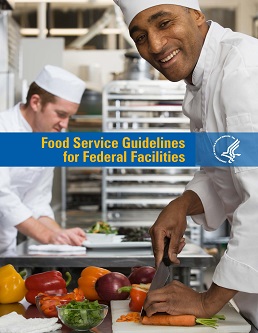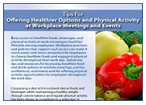Healthy Food Service Guidelines
 Every day, millions of Americans buy or are served food and beverages at their workplaces, or in other community settings such as hospitals, parks and recreation areas. Making changes in the types of food and beverages available in these settings can help improve the diets of people who eat there.
Every day, millions of Americans buy or are served food and beverages at their workplaces, or in other community settings such as hospitals, parks and recreation areas. Making changes in the types of food and beverages available in these settings can help improve the diets of people who eat there.
Food service guidelines are used to create a food environment in which healthier choices are more available for consumers. These guidelines are used to increase the availability of healthier food and beverages, and to display them more prominently, so that healthier options are more accessible. Food service guidelines should be a part of a comprehensive strategy to promote health and wellness in the workplace.
Potential benefits of healthy food service guidelines:
- Contribute to health and wellness of employees
- Set a positive example for employees, stakeholders, community members, or other employers
- Increase consumer demand for healthier food provided by food suppliers
- Strengthen local food systems
- Build awareness and support among organizational leadership, budget managers, and purchasing staff for healthier food and beverage options
Resources
 CDC has developed the following resources for implementing food service guidelines to provide healthier food and beverage options.
CDC has developed the following resources for implementing food service guidelines to provide healthier food and beverage options.
The Food Service Guidelines for Federal Facilities [PDF-3.40MB] document includes guidelines to assist contractors in increasing healthy food and beverage choices in federal worksites. The Food Service Guidelines for Federal Facilities is a set of voluntary best business practices that can be implemented to increase healthy and safe food options for employees.
Providing healthy choices
In alignment with the 2015-2020 Dietary Guidelines for Americans, the guidelines include food and nutrition standards that support healthier choices, such as
- A variety of fruit and vegetable options, including seasonal
- Whole grain-rich options, including pasta
- Plant-based proteins
- Lean protein entrees
- Low-fat milk, yogurt and cottage cheese
- High fiber, low sugar cereals
- Freely available drinking water
- Foods with less sodium
Enabling efficient facility practices
The guidelines support more efficient food service practices, such as
- Offering incentives for using reusable beverage containers.
- Using green cleaning and pest control practices.
- Using compostable and bio-based trays, flatware, plates, and bowls.
- Offering food that is organically, locally or sustainably grown and labeled accordingly.
- Where seafood options offered, provide those procured from responsibly managed, sustainable, healthy fisheries.
These guidelines help make the healthier choice the easier choice through calorie labeling of food items, making healthier options more available and limiting less healthful foods.
 The Smart Food Choices: How to Implement Food Service Guidelines in Public Facilities [PDF-1.82MB] guide includes action steps to help you implement food service guidelines in your government work site or other public facility to increase the availability of healthier food and beverage options at food service venues, including cafeterias, concession stands, snack bars, and vending machines.
The Smart Food Choices: How to Implement Food Service Guidelines in Public Facilities [PDF-1.82MB] guide includes action steps to help you implement food service guidelines in your government work site or other public facility to increase the availability of healthier food and beverage options at food service venues, including cafeterias, concession stands, snack bars, and vending machines.
 The Food Service Guidelines: Case Studies from States and Communities [PDF-1.9MB] highlights five case studies of food and beverage guidelines developed to improve the food environment. The case studies provide information on the implementation and evaluation of food service guidelines, along with descriptions of site-specific successes and challenges.
The Food Service Guidelines: Case Studies from States and Communities [PDF-1.9MB] highlights five case studies of food and beverage guidelines developed to improve the food environment. The case studies provide information on the implementation and evaluation of food service guidelines, along with descriptions of site-specific successes and challenges.
 The Tips For Offering Healthier Options and Physical Activity at Workplace Meetings and Events [PDF-587KB] document includes tips and resources for increasing healthier food and beverage options at worksite meetings, parties, conferences, and events and for offering physical activity opportunities for employees throughout the work day.
The Tips For Offering Healthier Options and Physical Activity at Workplace Meetings and Events [PDF-587KB] document includes tips and resources for increasing healthier food and beverage options at worksite meetings, parties, conferences, and events and for offering physical activity opportunities for employees throughout the work day.
 The Healthy Hospital Environments toolkit provides guidance to promote and support healthy food, beverage, and physical activity options in hospitals. It includes information about engaging stakeholders, assessing needs, and it also contains assessment tools for food, beverage and physical activity environments.
The Healthy Hospital Environments toolkit provides guidance to promote and support healthy food, beverage, and physical activity options in hospitals. It includes information about engaging stakeholders, assessing needs, and it also contains assessment tools for food, beverage and physical activity environments.

This 'Under Pressure' series of guides includes strategies for sodium reduction in a variety of settings for use when improving the food environment.
- Under Pressure: Strategies for Sodium Reduction in Worksites [PDF-1.36MB]
- Under Pressure: Strategies for Sodium Reduction in Hospitals [PDF-736KB]
- Under Pressure: Strategies for Sodium Reduction in the School Environment [PDF-1.84MB]
- Under Pressure: Strategies for Sodium Reduction in Institutionalized Populations [PDF-1.19MB]
 The Improving the Food Environment Through Nutrition Standards: A Guide for Government Procurement [PDF-652KB] document provides practical guidance to states and localities for use when developing, adopting, implementing, and evaluating a food procurement policy.
The Improving the Food Environment Through Nutrition Standards: A Guide for Government Procurement [PDF-652KB] document provides practical guidance to states and localities for use when developing, adopting, implementing, and evaluating a food procurement policy.
Success Stories
The Healthy Hospital Practice to Practice (P2P) series presents case studies of hospitals that have improved their environments to better support the health of their employees and communities and the mission of their organizations. Read how some hospitals have improved healthier offerings in their cafeteria and vending machines.
- Issue #1: Improving Hospital Food and Beverage Environments [PDF-1.3MB]
Find out how Cleveland Clinic and Good Shepherd Hospital are leading the way by offering a healthier food and beverage environment. - Issue #2: Improving Hospital Food and Beverage Environments [PDF-1.27MB]
Fairview Hospital and Baptist Health South Florida share how they are supporting employee health by changing their food and beverage policies and practices. - Issue #3: Improving Hospital Food and Beverage Environments [PDF-824KB]
Saint Vincent Healthcare and University Health Systems of Eastern Carolina describe the steps they are taking to help employees make healthy choices.
Implementing Healthier Food Service Guidelines in Hospital and Federal Worksite Cafeterias
To better understand the facilitators and barriers of implementing healthy food service guidelines, CDC supported a project by the North Carolina Institute of Public Health (NCIPH) to examine five hospitals and four federal worksite food service operators across the country.
The findings are published in the Journal of Human Nutrition and Dietetic and describe the experiences of food service operators in implementing healthy food service guidelines and identifies implementation facilitators and barriers.
NCIPH conducted additional follow-up with food service operators that were most successful in implementing the food service guidelines and published five success stories that highlight the implementation, challenges and solutions and keys to successes for each individual hospital or federal worksite food service operator.
- Page last reviewed: January 20, 2017
- Page last updated: January 20, 2017
- Content source:


 ShareCompartir
ShareCompartir